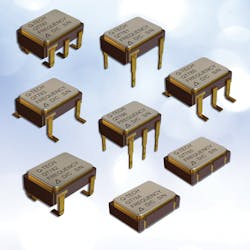Q-Tech introduces next-gen crystal oscillators for LEO applications
Space-Qualified crystal oscillators optimized for low-earth-orbit, large constellation satellite applications; parts standardization plus multiple package configurations address design constraints, enable delivery time and cost-saving benefits
CULVER CITY, CA—Q-Tech Corporation, supplier of crystal oscillators for space, military, avionics and high-temperature applications, has introduced the QT780 Series of space qualified crystal oscillators, designed for use as primary clocks in low earth orbit, small communications and broadcasting satellites. The QT780Exceptional reliability–an essential requirement for devices in this application–is supported by a combination of performance specifications, including: 50kRad(Si) total dose ionization radiation hardening and 20,000 g shock resistance. Optional screening per MIL-PRF-55310, Lvl B with PIND to meet DLA specs including particle impact noise detection is also available.
Q-Tech’s low profile, small footprint (5.0 x 7. 0 mm), extreme high-shock hybrid oscillators consist of an IC operating at various supply voltages (1.8V, 2.5V, 3.3V,5.0V) and a miniature strip quartz crystal. The series is offered in selected ceramic package configurations from surface-mount (SMT) to straight leads and formed leads.
“The QT780 Series is designed to meet the new requirements of our customers in the fast-growing, large constellation satellite market,” said Scott Sentz, Q-Tech’s Director of Sales and Marketing. “We are applying our 35-plus years of knowledge, experience and space heritage to deliver this new generation of application-optimized devices.”
Availability: Now
Delivery: 12 weeks (w/o optional MIL-PRF screening)
Price: Consult factory (dependent on package, frequency and screening level)

